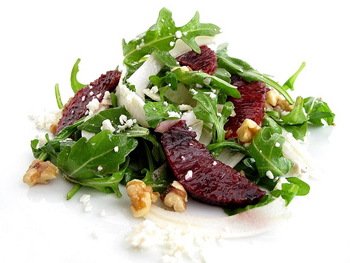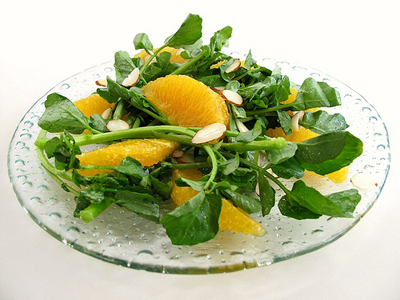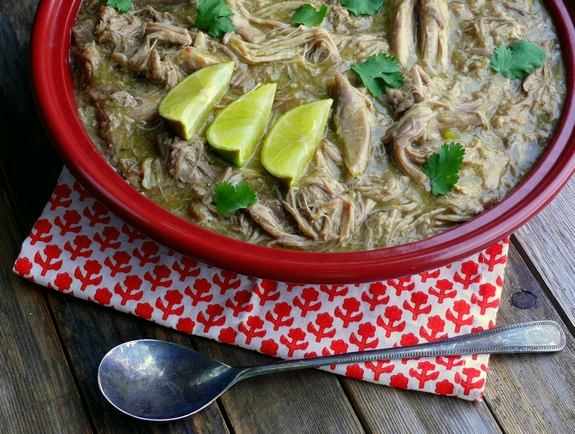 Blood oranges are all over the markets right now. It's actually very surprising, because a few years ago I could not find a blood orange anywhere but in the city. In my local supermarket they've even started selling them in bulk bags. Last week I saw packages upon packages of blood oranges in the reduced-price produce bin and of course I bought them, because there was nothing wrong with them. That tells me that people don't buy them because they don't know what to do with them. I've made this Valentine's dessert with them. I eat blood oranges throughout the season just as I do regular oranges. I enjoy the unique taste: very citrusy but more mellow with the flavor of dark fruits like raspberries or blackberries. Plus blood oranges share the same beneficial antioxidants as dark fruits.
Blood oranges are all over the markets right now. It's actually very surprising, because a few years ago I could not find a blood orange anywhere but in the city. In my local supermarket they've even started selling them in bulk bags. Last week I saw packages upon packages of blood oranges in the reduced-price produce bin and of course I bought them, because there was nothing wrong with them. That tells me that people don't buy them because they don't know what to do with them. I've made this Valentine's dessert with them. I eat blood oranges throughout the season just as I do regular oranges. I enjoy the unique taste: very citrusy but more mellow with the flavor of dark fruits like raspberries or blackberries. Plus blood oranges share the same beneficial antioxidants as dark fruits.
This year blood oranges haven't been as sweet as in the past, but they are great for use in savory dishes, such as this salad. I start with a base of peppery arugula and thinly shaved fennel. The final touches are slices of blood orange, crumbled feta, and toasted walnuts. The anise flavors of the fennel, the peppery arugula, and the salty feta are a very nice match for the blood oranges.
Winter
Winter
What's More Fun Than Saying Lemonquat?

A soft-spoken, affable farmer named George T. Schnurer, who owns and operates Betty B's Ranch in Ramona, California, sells a wide variety of cheerful citrus, including orangequats, lemonquats, and di rigeur Meyer lemons.
Though the juicy sweet-tart orangequats have a robust orange flavor that I love, I am positively smitten with the lemonquats. You might expect given their name that lemonquats are overly sour or acidic. They aren't. Like lemon drops, they're rather sweet with hints of tartness.
Lemonquats like kumquats are entirely edible. Though wonderful raw, they're simply amazing in baked goods. Despite their playful name and unique flavor, there aren't too many recipes for lemonquats, that is, except for hard drinks. Since this is G- rated blog, I figured I'd do something more wholesome, like cake.
Watercress and Minneola Tangelo Salad
 There is probably no other fruit more versatile than citrus. Most people would assume citrus fruit, because it's sweet, can only be used in desserts. But citrus is great in both sweet and savory recipes. Just think of lemons, which are widely used in Mediterranean cuisine. And oranges, too, are often used in savory recipes. Citrus juice also makes a flavorful marinade and tenderizer for meats. I love oranges in salads, especially when they are paired with Asian flavors in the form of a dressing. This salad features peppery watercress, flaked almonds for crunch, and tangelos, which lend wonderful flavor and juiciness.
There is probably no other fruit more versatile than citrus. Most people would assume citrus fruit, because it's sweet, can only be used in desserts. But citrus is great in both sweet and savory recipes. Just think of lemons, which are widely used in Mediterranean cuisine. And oranges, too, are often used in savory recipes. Citrus juice also makes a flavorful marinade and tenderizer for meats. I love oranges in salads, especially when they are paired with Asian flavors in the form of a dressing. This salad features peppery watercress, flaked almonds for crunch, and tangelos, which lend wonderful flavor and juiciness.
My love for citrus fruit continues this week with tangelos. You have probably heard of tangerines, so that is half the story behind tangelos, which are a genetic cross between grapefruits and tangerines. The most popular variety is the Minneola, named after the city in Flordia. The fruit features a knobby stem end and has easy-to-peel skin and juicy flesh. The flavor and aroma of tangelos are very unique, not too sweet and exotically subtle. I've only been familiar with tangelos for a few years now, but I've come to love eating them almost immediately. Their juice is what makes them so renowned.
Meyer Lemon Pasta
 My love for Meyer lemons continues this week with another dish using these amazingly flavorful citrus fruits. This time it's a pasta dish that's done in less than 15 minutes. It's meatless, so it's great for vegetarians. But the savory flavors of garlic and crushed red pepper will also appeal to the meat-and-potatoes guys. But what really lifts this dish is the Meyer lemons, which add a tantalizing zing that refreshes the palate.
My love for Meyer lemons continues this week with another dish using these amazingly flavorful citrus fruits. This time it's a pasta dish that's done in less than 15 minutes. It's meatless, so it's great for vegetarians. But the savory flavors of garlic and crushed red pepper will also appeal to the meat-and-potatoes guys. But what really lifts this dish is the Meyer lemons, which add a tantalizing zing that refreshes the palate.
As fast as you can boil pasta is as fast as you can make this recipe. The sauce is made with just the lemons and some pasta water. Then it's a matter of finishing it off with Parmesan cheese and parsley.
Make this meal in minutes—it's perfect for the weeknight when you're lacking the time or creativity to make anything complex. And if you can't find Meyer lemons, use regular ones and get results that are just as great.
Slow Cooker Pulled Pork Chile Verde
 Seriously folks what is with all the bad weather in the U.S.? When I'm tooling around on Facebook I feel like I've been living everyone's bad weather, including my own. So much snow everywhere. Let's hope Spring comes a little early this year. All these gloomy days means the slow cooker has been earning its keep. This Pulled Pork Chile Verde has been something I've been working on. But today it was perfect and that's why I'm sharing it with you.
Seriously folks what is with all the bad weather in the U.S.? When I'm tooling around on Facebook I feel like I've been living everyone's bad weather, including my own. So much snow everywhere. Let's hope Spring comes a little early this year. All these gloomy days means the slow cooker has been earning its keep. This Pulled Pork Chile Verde has been something I've been working on. But today it was perfect and that's why I'm sharing it with you.
My goals for this recipe were straightforward. I wanted a dish that makes enough food for several meals, reheats well, lower in calories and a version even picky eater kids would eat and love. All were accomplished!
In regards to meal times, my older son is easier to please than my younger one. Let's just say I have a real critic when it comes to what he wants to or will eat. But he loved this. I purposefully made it mild enough so the kids would enjoy it. You can do the same and add hot sauce to get the heat you prefer or use a spicier sauce to begin with.
More Articles ...
Welcome to the new One for the Table ...
Our Home Page will be different each time you arrive.
We're sure you'll find something to pique your interest...


